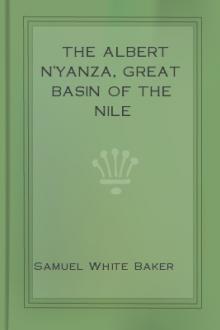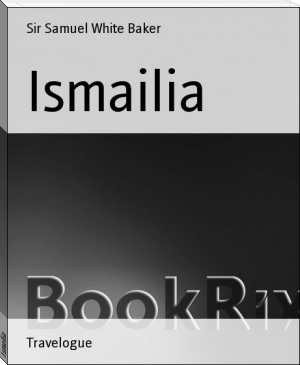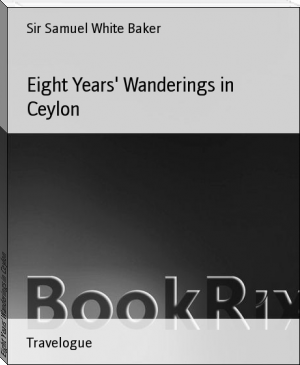The Albert N'Yanza, Great Basin of the Nile, Samuel White Baker [inspirational novels .TXT] 📗

- Author: Samuel White Baker
- Performer: -
Book online «The Albert N'Yanza, Great Basin of the Nile, Samuel White Baker [inspirational novels .TXT] 📗». Author Samuel White Baker
were: people died daily.
“The White Nile was dammed up by a freak of nature, and the crews of
thirty vessels had been occupied five weeks in cutting a ditch through
the obstruction, wide enough to admit the passage of boats.”
Such was the intelligence received by the latest arrival from Khartoum.
No boats having been sent for me, I engaged the diahbiah that had
arrived for Koorshid’s ivory;—this would return empty, as no ivory
could be delivered at Gondokoro. The prospect was pleasant, as many men
had died of the plague on board our vessel during the voyage from
Khartoum; thus we should be subject to a visitation of this fearful
complaint as a wind-up to the difficulties we had passed through during
our long exile in Central Africa. I ordered the vessel to be thoroughly
scrubbed with boiling water and sand, after which it was fumigated with
several pounds of tobacco, burnt within the cabin.
Three days were employed in ferrying the slaves across the river in the
two noggurs, or barges, as they must be returned to their respective
stations. I rejoiced at the total discomfiture of the traders, and,
observing a cloud of smoke far distant to the north, I spread the alarm
that a steamer was approaching from Khartoum! Such was the consternation
of the traders’ parties at the bare idea of such an occurrence that they
prepared for immediate flight into the interior, as they expected to be
captured by Government troops sent from Khartoum to suppress the
slave-trade. Profiting by this nervous state of affairs, I induced them
to allow the boat to start immediately, and we concluded all our
arrangements, contracting for the diahbiah at 4,000 piastres (40
pounds). The plague having broken out at Gondokoro, the victims among
the natives were dragged to the edge of the cliff and thrown into the
river;—it is impossible to describe the horrible effluvium produced by
the crowds of slaves that had been confined upon the limited area of the
station. At length the happy moment arrived that we were to quit the
miserable spot. The boat was ready to start—we were all on board, and
Ibrahim and his people came to say goodbye. It is only justice to
Ibrahim to say, that, although he had been my great enemy when at
Gondokoro in 1863, he had always behaved well since peace was
established at Ellyria; and, although by nature and profession a
slave-hunter, like others of the White Nile, he had frequently yielded
to my interference to save the lives of natives who would otherwise have
been massacred without pity.
I had gained an extraordinary influence over all these ruffianly people.
Everything that I had promised them had been more than performed; all
that I had foretold had been curiously realized. They now acknowledged
how often I had assured them that the slave-trade would be suppressed by
the interference of European powers, and the present ruin of their trade
was the result; they all believed that I was the cause, by having
written from Gondokoro to the Consul-general of Egypt in 1863, when the
traders had threatened to drive me back. Far from retaliating upon me,
they were completely cowed. The report had been spread throughout
Gondokoro by Ibrahim and his people that their wonderful success in
ivory hunting was chiefly due to me; that their sick had been cured;
that good luck had attended their party; that disaster had befallen all
who had been against me; and that no one had suffered wrong at our
hands. With the resignation of Mahommedans they yielded to their
destiny, apparently without any ill-feeling against us. Crowds lined the
cliff and the high ground by the old ruins of the mission station to see
us depart. We pushed off from shore into the powerful current; the
English flag that had accompanied us all through our wanderings now
fluttered proudly from the masthead unsullied by defeat, and amidst the
rattle of musketry we glided rapidly down the river, and soon lost sight
of Gondokoro.
What were our feelings at that moment? Overflowing with gratitude to a
Divine Providence that had supported us in sickness, and guided us
through all dangers. There had been moments of hopelessness and despair;
days of misery, when the future had appeared dark and fatal; but we had
been strengthened in our weakness, and led, when apparently lost, by an
unseen hand. I felt no triumph, but with a feeling of calm contentment
and satisfaction we floated down the Nile. My great joy was in the
meeting that I contemplated with Speke in England, I had so thoroughly
completed the task we had agreed upon.
Silently and easily we floated down the river; the oars keeping us in
midstream. The endless marshes no longer looked so mournful as we glided
rapidly past, and descended the current against which we had so
arduously laboured on our ascent to Gondokoro. As we thus proceeded on
our voyage through the monotonous marshes and vast herds of hippopotami
that at this season thronged the river, I had ample leisure to write my
letters for England, to be posted on arrival at Khartoum, and to look
back upon the results of the last few years. The Nile, cleared of its
mystery, resolves itself into comparative simplicity. The actual basin
of the Nile is included between about the 22 degree and 39 degree East
longitude, and from 3 degrees South to 13 degrees North latitude. The
drainage of that vast area is monopolized by the Egyptian river. The
Victoria and Albert lakes, the two great equatorial reservoirs, are the
recipients of all affluents south of the Equator; the Albert lake being
the grand reservoir in which are concentrated the entire waters from the
south, in addition to tributaries from the Blue Mountains from the north
of the Equator. The Albert N’yanza is the great basin of the Nile: the
distinction between that and the Victoria N’yanza is, that the Victoria
is a reservoir receiving the eastern affluents, and it becomes a
starting point or the most elevated SOURCE at the point where the river
issues from it at the Ripon Falls: the Albert is a reservoir not only
receiving the western and southern affluents direct from the Blue
Mountains, but it also receives the supply from the Victoria and from
the entire equatorial Nile basin. The Nile as it issues from the Albert
N’yanza is the ENTIRE Nile; prior to its birth from the Albert lake it
is NOT the entire Nile. A glance at the map will at once exemplify the
relative value of the two great lakes. The Victoria gathers all the
waters on the eastern side and sheds them into the northern extremity of
the Albert: while the latter, from its character and position, is the
direct channel of the Nile that receives all waters that belong to the
equatorial Nile basin. Thus the Victoria is the first SOURCE; but from
the Albert the river issues at once as the great White Nile.
It is not my intention to claim a higher value for my discovery than is
justly due, neither would I diminish in any way the lustre of the
achievements of Speke and Grant; it has ever been my object to confirm
and support their discoveries, and to add my voice to the chorus of
praise that they have so justly merited. A great geographical fact has
through our joint labours been most thoroughly established by the
discovery of the sources of the Nile. I lay down upon the map exactly
what I saw, and what I gathered from information afforded by the natives
most carefully examined.
My exploration confirms all that was asserted by Speke and Grant: they
traced the country from Zanzibar to the northern watershed of Africa,
commencing at about 3 degrees South latitude, at the southern extremity
of the Victoria N’yanza. They subsequently determined the river at the
Ripon Falls flowing from that lake to be the highest source of the Nile.
They had a perfect right to arrive at this conclusion from the data then
afforded. They traced the river for a considerable distance to Karuma
Falls, in lat. 2 degrees 15 minutes N.; and they subsequently met the
Nile in lat. 3 degrees 32 minutes N. They had heard that it flowed into
the Luta N’zige, and that it issued from it; thus they were correct in
all their investigations, which my discoveries have confirmed. Their
general description of the country was perfect, but not having visited
the lake heard of as the Luta N’zige, they could not possibly have been
aware of the vast importance of that great reservoir in the Nile system.
The task of exploring that extraordinary feature having been
accomplished, the geographical question of the sources of the Nile is
explained. Ptolemy had described the Nile sources as emanating from two
great lakes that received the snows of the mountains of Ethiopia. There
are many ancient maps existing upon which these lakes are marked as
positive: although there is a wide error in the latitude, the fact
remains, that two great lakes were reported to exist in Equatorial
Africa fed by the torrents from lofty mountains, and that from these
reservoirs two streams issued, the conjunction of which formed the Nile.
The general principle was correct, although the detail was wrong. There
can be little doubt that trade had been carried on between the Arabs
from the Red Sea and the coast opposite Zanzibar in ancient times, and
that the people engaged in such enterprise had penetrated so far into
the interior as to have obtained a knowledge of the existence of the two
reservoirs; thus may the geographical information originally have been
brought into Egypt.
The rainfall to within 3 degrees north of the Equator extends over ten
months, commencing in February and terminating in the end of November.
The heaviest rains fall from April till the end of August; during the
latter two months of this season the rivers are at their maximum: at
other times the climate is about as uncertain as that of England; but
the rain is of the heavy character usual in the tropics. Thus the rivers
are constant throughout the year, and the Albert lake continues at a
high level, affording a steady volume of water to the Nile. On the map
given to me by Captain Speke he has marked the Victoria Nile below the
Ripon Falls as the Somerset river. As I have made a point of adhering to
all native names as given by him upon that map, I also adhere to the
name Somerset river for that portion of the Nile between the Victoria
and the Albert Lakes; this must be understood as Speke’s VICTORIA NILE
source; bearing the name of Somerset, no confusion will arise in
speaking of the Nile, which would otherwise be ambiguous, as the same
name would apply to two distinct rivers—the one emanating from the
Victoria and flowing into the Albert; the other the entire river Nile as
it leaves the Albert lake. The White Nile, fed as described by the great
reservoirs supplied by the rains of equatorial districts, receives the
following tributaries:
From the East bank—The Asua, important from 15th April till 15th
November: dry after that date.
From West bank—The Ye, third class; full from 15th April till 15th
November.
From West bank—Another small river, third class; full from 15th April
till 15th November.
Ditto—The Bahr el Gazal; little or no water supplied by this river.
From East bank—The Sobat, first class; full from June to December.
The Bahr Giraffe I omit, as it is admitted by the natives to be a branch
of the White Nile that leaves the main river at the Aliab country and
reunites in





Comments (0)